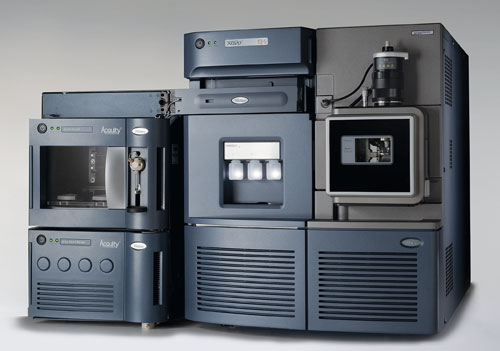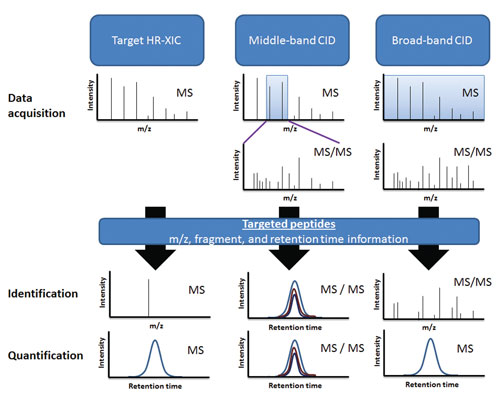June 15, 2012 (Vol. 32, No. 12)
Kate Marusina Ph.D.
Mass spectrometry (MS) is firmly established as a technique of choice for unraveling structural characteristics of chemical compounds. However, until recently, detection of low abundant peptide and protein analytes remained challenging because of poor efficiencies in ion formation and transmission.
The recent “American Society For Mass Spectrometry” conference was largely dedicated to the changing role of MS in proteomics analysis. Recent developments in instrument design have led to lower limits of detection, and better understanding of gas-phase chemistry has opened possibilities for more sophisticated peptide and protein analysis.
The technologies featured in this article are only a few of the conference highlights underscoring the recent and anticipated developments in MS and related techniques applied to the analysis of dynamic proteomes.
Consistent identification and quantification of target peptides, especially those present in low abundance, is essential for diagnosis and prognosis of diseases. This level of precision is not quite achievable by current proteomic technologies. A new MS-based approach, termed selective reaction monitoring (SRM), is emerging as a technology that has a unique potential for reliable quantification of low abundance analytes.
SRM exploits the unique capabilities of triple quadrupole mass spectrometers. A quadrupole is a component of the instrument responsible for filtering sample ions, based on their mass-to-charge ratio. For SRM, three quadrupoles are deployed, with the first and the third components acting as mass-charge filters, and the second acting as a collision cell.
“For each target protein we select several peptides that uniquely define the target in the MS profile,” said Theo Luider, Ph.D., head of the laboratories of neuro-oncology, department of neurology, Erasmus Medical Center.
“Next, these peptides are fragmented and fragment ions are separated by mass and charge again. This process creates a set of unique transitions from peptide to fragment for each peptide. Monitoring three to four transitions for each target peptide accurately quantifies any target peptide in the cellular proteome in a reproducible manner.”
By using SRM, the team was able to quantify two selected fragments of calcyclin, a putative biomarker for pre-eclampsia. Although the case of pre-eclampsia, a life-threatening condition associated with 8% of pregnancies, is not yet understood, its onset was associated with increased transcription of certain placental proteins.
Dr. Luider and his colleagues used laser microdissected materials from paraffin-embedded placental tissue.
“We used stable-isotope labeled analogs of target peptides to spike the samples,” continued Dr. Luider. “These analogs are chemically identical to native peptides; they behave identically on the separation columns and produce identical transitions. Comparison with such internal reference standards confirms the recovery of calcyclin peptides and determines their absolute amounts in the sample.”
The most recent study quantified calcyclin in serum samples. Endogeonus levels of calcyclin were detectable in crude serum, but fractionation on the cation-exchange column significantly improved signal detection. “Now that we have improved the method, we would like to validate the diagnostic potential of SRM technology using larger patient cohorts,” added Dr. Luider.

Researchers at Erasmus Medical Center are using SRM, which exploits the unique capabilities of triple quadrupole mass spectrometers in their pre-eclampsia research. [Waters]
Enhancing Biomarker Discovery
“SRM delivers a unique fragment ion that can be monitored and quantified in the midst of a very complicated matrix,” said Melissa Radabaugh, senior R&D scientist, Sigma-Aldrich. “However, to achieve the desired result, the column, ionization source, and the flow rate need to be optimized.”
Previously, while at Pfizer, Radabaugh and her team greatly improved the sensitivity of detection of nitrotyrosine, a marker of many pathological conditions resulting from oxidative/nitrative cell damage, by developing an on-line immunoaffinity SRM LC-MS/MS method. Optimization of the process parameters enabled detection of nitrotyrosine in the low picomolar levels. Coupling with an antibody column further improved the specificity of detection.
The assay was tested on a variety of biological fluids including urine, plasma, and cerebrospinal fluid, ensuring that the method is robust enough to support evaluation of nitric oxide-driven pathologies and their response to treatment.
Radabaugh’s most recent study optimized a system for quantification of peptides. In order to translate these studies into clinic-based diagnostics, the serum samples were spiked with a nonhuman synthetic peptide. These defined standard mixtures were used for optimization of liquid chromatography (LC) and MS parameters.
The team tested various separation parameters such as flow rates, peak shape, retention time, and delay-time volumes using several separation columns. The goal was to achieve the optimal separation using capillary flow rates as opposed to a more commonly used nanoflow. In the context of analyzing proteins by SRM, capillary flow has a number of advantages. This flow rate prevents issues of clogging when complex protein mixtures are used.
The column with the best outcomes was coupled with different ionization sources. The ion source is the first part of the mass spectrometer and is used to ionize the sample. Under the testing conditions, the Michrom Advance source demonstrated the strongest signal. As a whole, the system was able to uptake a larger amount of sample, making this a useful system for biomarker discovery, quantitation, and validation.
“The advantages of microflow includes the ability to load a larger sample and to achieve better separation,” said Tina Settineri, Ph.D., director, HPLC products, Eksigent division of AB Sciex.
“However, nanoflow provides the absolute best sensitivity for mass spectrometry, because the sample becomes highly concentrated. For added flexibility between nanoflow and microflow LC, nanoLC customers can effortlessly convert between nano- and microflow by interchanging the flow channels in our 2D nanoLC systems, such as the NanoLC-Ultra® 2Dplus system. Furthermore, Eksigent’s ekspert™ microLC 200 system enables two different flow-rate ranges.”
The most recent enhancement coupled the nanoflow liquid chromatography with high-performance mass spectrometry to achieve the best possible combination of high sensitivity and high acquisition speeds. This combination of hardware is essential to deal with samples of high complexity, such as serum or cellular digests.
“The key to increasing protein separation on the nanoLC was to increase the column length,” continued Dr. Settineri. “This in turn increased the separation time, and hence the time available for MS/MS acquisition, resulting in the most proteins identified utilizing just under 50 MS/MS scans per second. By going from a 15 cm column to a 30 cm column, we were able to increase the number of identified proteins by 20%, while keeping the identification errors to less than 1%.”
The company is exploring ways to further increase column length to 50 cm in order to extend coverage to a more complete proteome. The analysis was performed on the TripleTOF™5600 system, a top of the line hybrid quadrupole time of flight (TOF) mass spectrometer.
This instrument is a central piece of the proteomic technique that quantifies nearly all proteins in a sample in a single analysis. SWATH™ Acquisition does not simply detect a single precursor ion. Instead, it uses a certain predefined mass range to perform MS/MS acquisition. SWATH technique generates highly specific fragment ion data for all peptides within this mass range.
Resulting fragment ion chromatograms uniquely identify each peptide of interest, just like in SRM. The technique provides a complete quantitative profile of all proteins in the sample.
Double Duty
“Scientists can apply different MS approaches to answer discreet scientific questions relevant to specific steps of the biomarker discovery and validation pathway,” agreed Carsten Baessmann, Ph.D., head of applications development LC/MS, Bruker Daltonik.
“Bruker’s new maXis impact™ ultra high resolution TOF mass spectrometer enables us to use all common approaches for discovery and validation on a single instrument. Moreover, maXis impact delivers the analysis over the four orders of dynamic range with sub-ppm mass accuracy.”
The team explored the performance of the maXis impact using three different options for targeted proteomics. The first approach was to narrowly define the target mass range and to determine the dynamic range and the lower limits of quantitation in a one-dimensional MS separation.
“We were able to define the mass range within millidaltons of the target ion,” said Stephanie Kaspar, proteomics scientist in applications development. “This means that we can successfully distinguish the target from the matrix, even at the concentrations as low as 25–50 attomoles.”
Alternatively the instrument can be switched to the middle-band CID (collision induced dissociation) mode. In this mode, a narrow mass window of 26 daltons is selected to generate the fragments in the second MS dimension. By using overlapping 26 dalton windows, the entire mass range can be scanned.
The resulting ion chromatograms are analyzed to derive either relative sample-to-sample quantitation or absolute quantitation against the reference standard. High-resolution power of maXis impact UHR-TOF enables efficient separation of the adjacent ions, which is critical for identification of unknowns in complex biological samples.
“Using the third approach, the broad-band CID, we quantify target peptides over the entire mass range and confirm the identity via fragment information, without selecting any particular mass window,” continued Dr. Baessmann.
In the first MS dimension, all peptides are quantified. Next, the identity of each peptide is verified by fragmentation and analysis of the resulting ions. For forensic toxicology this approach results in the least number of false positives.
For example, co-eluting dibenzipin and a doxpin metabolite, with a mass difference of 11.2 millidaltons, were correctly identified in authentic urine samples. Further studies are aimed at applying these technologies to identifying and quantifying peptides from biological and clinical samples.

The three different workflows applied for targeted proteomics on Bruker Daltonik’s maXis impact.
Clinical Diagnosis of Alzheimer Disease
Proteome Sciences has perfected SRM technology for the quantitation of Tau phospho-peptides, one of the main components of Alzheimer disease (AD). Tau is believed to stabilize microtubules in cells and may play a role in regulating synaptic signaling.
Phosphorylation of Tau results in detachment from the cellular scaffold, followed by formation of tangles characteristic for AD pathology. Tau can be phosphorylated at over 30 specific sites. The pattern of Tau phosphorylation seems to correlate with severity of pathological progression of the AD.
“If we detect and quantify Tau phosphorylation at individual amino acids, we will be able to aid in clinical diagnostics and to stratify patients for clinical trials,” commented Ian Pike, Ph.D., COO, Proteome Sciences.
In collaboration with Professor Brian Anderton at King’s College London, Proteome Sciences progressively identified kinases responsible for the phosphorylation process and their unique sites. The team singled out the CK1 delta kinase to be an early player in the sequence of Tau phosphorylation.
While pursuing validation of this kinase as a therapeutic target for its internal drug discovery program, Proteome Sciences secures contract biomarker services with pharmaceutical partners. The company provides SRM-based assays for absolute quantitation of total Tau protein and its phosphorylation at 10 sites. Tau can be tested in brain tissue, cells, and, soon, in cerebrospinal fluid.
“Not all required phosphorylation sites could be measured accurately using antibodies, and some of the phosphorylation sites are only one amino acid apart. So we spent a lot of effort optimizing the transitions for a multiplexed SRM assay,” continued Dr. Pike.
“In some models Tau contains mutations that lose the required trypsin cleavage point, therefore, we used an alternative peptidase to generate target peptides. Furthermore, we optimized the assay to detect Tau in different cellular fractions.”
In early 2012, expert international workgroups convened by the Alzheimer’s Association and the National Institute on Aging, an agency of the U.S. National Institutes of Health, have expanded AD diagnostic guidelines to include Tau. Proteome Sciences works with clients to develop customized assays for other phosphorylation sites to support drug development.
“SRM is the ideal technology for this application, providing highly discriminating measurements and high sensitivity,” concluded Dr. Pike.







